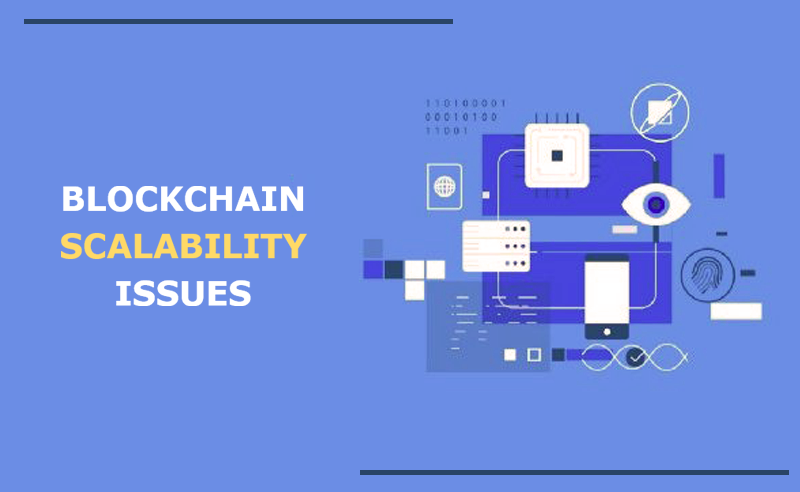Table of Contents
It will not be false to say that blockchain has evolved so much in the last few years but the truth is that we are still dealing with the issue of scalability. Starting 2009, after the launch of Bitcoin, till now, the only issue that is standing in front of blockchain’s wide adoption is the issue of scalability. In this article, we are going to talk about the challenges blockchain is facing in scaling its network and then look at the list of its potential solutions. Let’s start with our guide about blockchain scalability issues right away.
Major Blockchain Scalability Issues
With cryptocurrencies coming to the mainstream, a major issue that’s emerging is its scalability problem. Many solutions have been tried but there are still not enough to tackle the issue once for all. So, what are these issues exactly that we are talking about? Well, the major issues are the transaction speed, block size, response time, and fees. If you know the reason why Bitcoin Cash was hard forked from bitcoin in the first place, then you must be aware of Bitcoin’s block size and transaction speed issue.
In order to compete with existing payment methods, bitcoin needs to step up its game and tackle its blockchain scalability issue. Now if you compare the transaction processed in these systems per second with the transaction processed in Bitcoin, you’ll find out the real issue. While the visa processes up to 1667 transactions per second, PayPal manages 193 transactions per second. The number is as little as 20 transactions per second for Ethereum and only 7 transactions for Bitcoin. This could only be improved by working on the problem of scalability. So, let’s get to know about the various scalability issues with blockchain presently.

Blockchain In The Danger Of Buckling
With each transaction, one more block is added to the chain and every block contains the information of all the previous blocks. Now as the system is coming to the mainstream or say more and more people are joining the network, the history of transactions is also increasing. This triggers the danger of buckling as each block has to carry the data of all the previous blocks.
Block Size, Transaction Speed
Initially, Bitcoin’s block was hard-capped at 1 MB which is somewhat equal to 2,020 transactions. But as you know, with the increasing interest of people in Bitcoin, there are chances that each coin will take part in an infinite number of transactions. Which means that there would be infinite records of transactions to be stored on each block.
With the increasing number of transactions, there’s a need for an increase in block sizes that exceeds any limit. Although Bitcoin has exceeded its hard cap limit and Ethereum does not have any cap limit, there’s still one issue left to be fixed i.e the time taken for a transaction to be processed. The more will be the size of the block, the more will the time taken by each transaction to be completed.
Time Taken In Verifying Each Transaction
If we talk about Bitcoin, each transaction requires peer-to-peer verification which is time costly. Initially, bitcoin used to verify or create one block in ten minutes. But now, the network is taking hours for the same due to the fact that there is more traffic. The more the transactions, the more time it would take to verify each block and eventually you would have to wait longer for your transaction to get processed. This clearly needs to be fixed if blockchain wants to be able to compete with other existing payment systems.
Transaction Charges
Here, also we will talk about Bitcoin in major. After all, bitcoin is still the leading cryptocurrency. So, with the increasing traffic on Bitcoin’s network is increasing the number of transactions and hence the need for more nodes to process the transaction. The running costs for nodes aren’t any cheap and even miners show significant interest in high transaction fees. Partly, this is due to the fact that they have to work and put a lot of money themselves to verify transactions. That being said we are referring to the increase in transaction fees during the peak times. Many new cryptocurrencies have tackled this issue either by using different protocols or other means among which some altcoins even provide zero-fee transactions.
These aren’t the only issues blockchains are facing as it varies accordingly. But we gave you the outline so that you would be aware of what types of blockchain scalability issues we are talking about. Now, let’s talk about the solutions that have been implemented or going to be implemented to fix these problems.
Potential Solutions
Not only Bitcoin but Ethereum have come across many many solutions to fix its blockchain scalability issue. The major ones are listed below:
Proof of Stake: Bitcoin is based on proof of work protocol which is very costly and also requires a lot of energy. There are many limitations of proof of work algorithm which is covered up by the alternative new protocol proof of stake. Actually, proof of stakes comes with its own list of limitations and drawbacks because of which several other protocols are created like delegated proof of stake etc.
Segwit: The idea of a segregated witness aka Segwit was proposed by Dr Peter Wiulle of Blockstream. Segwit is only applicable for Bitcoin blockchain and is a process to increase the block size limit of the blockchain. This is done by removing certain data of transactions that would free up some space so that more transactions could be added to the chain.
Other such solutions include increasing the block size, plasma and sharding. If you want to know more about all these solutions, read more of our guides for these processes individually.
Conclusion:
There are many issues that blockchain needs to tackle in order to come to the mainstream and compete with existing payment methods. We hope you’ve got an outline of blockchain problems and solutions. You can find more such guides on our official cryptoknowmics.com portal.

